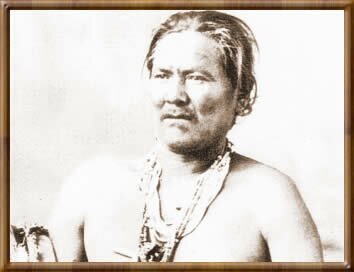Manuelito
(mahn yoo ayl ee toh)
1818? - 1893

Spanish for “Little Manuel,” or HastíCh’ilhajinii, also Childhajin, “The Man of the Black Weeds,” was the major Navajo war leader in the 19th century; another early name for him was Ashkii Dighin, “Holy Boy.” His war name, Hashkeh Naabah, “The Angry Warrior,” aptly described him. Little is known of his life before he was selected headman in 1855 to succeed Zarcillas Largas (Long Earrings). He is thought to have been born near Bear’s Ears, in southeastern Utah, about 1818, (some say 1820), into the Bit’ahni (Folded Arms People) clan. The Navajo at that time lived in the vast region including much of Arizona, New Mexico, Utah, and Colorado; they ranged widely throughout the Southwest and were responsible more to clan leaders than to single “head chiefs.” Each headman was responsible for the acts of his own people. The inability of Whites to recognize this political limitation was the basis for many of the misunderstandings between the two peoples.
By the end of the 1850s, many Navajo leaders, including Manuelito, had become wealthy through livestock, agriculture, and raids on Mexican and neighboring Indian tribes. But as the western territories became part of the United States after the Mexican War, this all changed. The Mexicans automatically became American citizens; but the Indians, although native occupants, did not. And when the Mexican-Americans made frequent raids on Navajo homes, kidnapping women and children to be sold as slaves, the U.S. Army seldom intervened; but when the Navajo retaliated, the government speedily punished them. In fact, Manuelito’s own home, crops, and livestock had been destroyed by soldiers in a “punishment raid” in 1859.
The next year he made several attacks on Fort Defiance, Arizona, the major military outpost at the time, and Colonel Edward R.S. Canby unsuccessfully pursued him. The Navajo knew their vast country so well that direct confrontation in battle rarely took place. In January 1861, Manuelito and other important leaders met with Canby and again agreed to try to keep the peace, even though Manuelito did not believe this was possible. By this time, the Civil War had erupted, and Army strength was greatly diminished. Many of the Navajo went to Fort Fauntleroy, New Mexico, to trade, and with the loose control, incidents and confrontations between Indian and White became commonplace.
In 1863, the situation was so critical that General James Carleton was sent from California with orders to remove all the Indians to a new reservation at Fort Sumner, New Mexico—a desolate area called Bosque Redondo, which was completely unable to support very many people. The Navajo were given a short time to surrender, when they defied his order, Carleton sent Kit Carson and his troops to destroy crops, livestock, and homes. The waste was so tremendous that the end was inevitable; Delgadito was the first to surrender in October 1863. Others followed and this was the beginning of the traumatic “Long Walk” of the Navajo from their homelands 350 miles southeast to Fort Sumner. Carleton had shrewdly arranged ample provisions and good treatment for this first group, and Delgadito was quite willing to return and try to persuade other chiefs to surrender.
Carson increased the pressure upon the outlying groups, raiding the Canyon de Chelly, a Navajo heartland, and by March, Navajo were surrendering by the thousands. Barboncito, one of the most important leaders, was captured, but Manuelito held out until late April, hoping that he and his people would be able to remain near the fort. His wish was refused, and Carson sent four Navajo to try to persuade him to surrender, without success. Then, in February 1865, Carleton sent six other Navajo headmen to plead with Manuelito, now the very last hold out, to surrender for the sake of his starving people. Still Manuelito refused, saying “I have nothing to lose but my life, and they can come and take that whenever they please . . . if I am killed, innocent blood will be shed.” But finally, in September, Manuelito and 23 of his warriors surrendered, their emaciated bodies clad only in rags.
But in the meantime, the plight of the Navajo now living at Bosque Redondo was appalling; there was no food or clothing, and the people were dying from starvation and disease. It was recognized that the harsh policies of Carleton were wrong and he was removed. In 1868 a new treaty was signed granting the Navajo a reservation back in their vast territory, along with livestock and food supplies. Manuelito served as head chief from 1870 to 1884, when he was succeeded by Henry Chee Dodge. He was also selected in 1872 to head the Indian Police force on the reservation.
He continued to be a strong force for the balance of his life, ever conscious of the needs of the Navajo. In 1876 he traveled to Washington where he met with President U.S. Grant to intervene for his people. He died in 1876 at the age of 75, one of the most respected figures in Navajo history.
He is known to have had two wives; the first was the daughter of Narbona, the great Navajo war chief from whom Manuelito learned so much. The second wife was a Mexican captive. He had several children but nothing is known of their careers.
Source: Great North American Indians by Frederick J. Duckstander